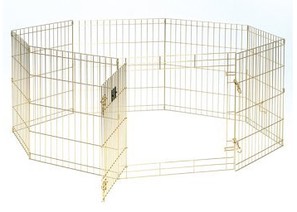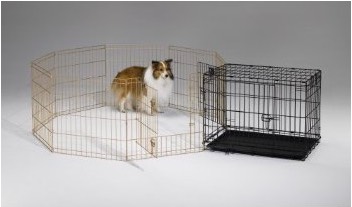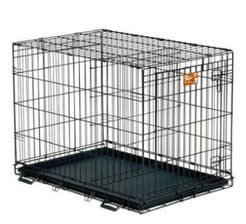Before you crate train, please be aware: a dog that is left in a crate all day long, gets let out in the evening after work for a few hours and put back in the crate for the night can become neurotic, destructive, unhappy and noisy. If you work all day, it is recommend that you find someone who can take your dog out for a long walk in the afternoon. If this is not possible only use the crate at night. If you must leave your dog all day long every day and you have nobody to let the dog out during the day, you should find a room without a rug, put down "wee-wee" pads, food, water and toys. You should set up the room so that the bed and food are at one end and the pee pads at the other. Spread the toys in the center of the room. Dogs are not fish. They need to find something to occupy their mind, so give your dog plenty of toys. It is said that dogs are den animals and like the crate, but even a den animal would go crazy if it was lock up all day long.
The Best Method of Confining Your Puppy - MODIFIED Crate Training:
(it works, especially for potty training and providing your pup's new "home" that mimics where they were raised)
There are alternative methods to crating very young puppies and puppies who must be left alone in the house for lengths of time exceeding the recommended maximum duration of confinement (see Crating Duration Guidelines). We suggest the following Exercise Pen (8-24" Panels x 30" High) is under $50 at Amazon compared to identical at Petsmart close to $100); and, combined with the crate as shown, or within the pen area:


Recommended Crate - 24"x36" Life Stages Crate by Midwest Products -
best cost (around $50 - $60 @ Amazon compared to double that at Petsmart), no tax, free shipping ... click Amazon link following - goes to product page: (also look at both "gold" finish and black finish - black is usually slightly cheaper)


available at Petsmart and/or Petco; or online from Amazon
Providing your puppy or dog with an indoor kennel crate can satisfy many dogs' need for a den-like enclosure. Besides being an effective housebreaking tool (because it takes advantage of the dog's natural reluctance to soil its sleeping place), it can also help to reduce separation anxiety, to prevent destructive behavior (such as chewing furniture), to keep a puppy away from potentially dangerous household items (i.e., poisons, electrical wires, etc.), and to serve as a mobile indoor dog house which can be moved from room to room whenever necessary.
A kennel crate also serves as a travel cabin for you dog when traveling by car or plane. Additionally, most hotels which accept dogs on their premises require them to be crated while in the room to prevent damage.
Most dogs which have been introduced to the kennel crate while still young grow up to prefer their crate to rest in or "hang-out" in. Therefore a crate (or any other area of confinement) should NEVER be used for the purpose of punishment.
Provide a kennel crate throughout your dog's lifetime. Some crates allow for the removal of the door once it is no longer necessary for the purpose of training. The crate can be placed under a table, or a table top can be put on top of it to make it more useful.
Furnishing Your Puppy's Crate
Toys and Treats:
Place your puppy's favorite toys and dog treats at the far end opposite the door opening. These toys may include the "Tuffy", "Billy", "Kong", "Nylabone" or a ball. Toys and bails should always be inedible and large enough to prevent their being swallowed. Any fragmented toys should be removed to prevent choking and internal obstruction. You may also place a sterilized marrow bone filled with cheese or dog treats in the crate.
Water:
A small hamster-type water dispenser with ice water should be attached to the crate if your puppy is to be confined for more than two hours in the crate.
Bedding:
Place a towel or blanket inside the crate to create a soft, comfortable bed for the puppy. If the puppy chews the towel, remove it to prevent the pup from swallowing or choking on the pieces. Although most puppies prefer lying on soft bedding, some may prefer to rest on a hard, flat surface, and may push the towel to one end of the crate to avoid it. If the puppy urinates on the towel, remove bedding until the pup no longer eliminates in the crate.
Location of Crate
Whenever possible, place the crate near or next to you when you are home. This will encourage the pup to go inside it without his feeling lonely or isolated when you go out. A central room in the apartment (i.e.: living room or kitchen) or a large hallway near the entrance is a good place to crate your puppy.
Notes About (true) Crating of Puppies
WARNING:Very young puppies under 9 weeks should be CAUTIOUSLY crated, as they need to eliminate very frequently (usually 6-12 times or more daily).
Important Reminders
1 Collars: Always remove your puppy or dog's collar before confining in the crate.
2 Warm Weather: Do not crate a puppy or dog when temperatures reach an uncomfortable level. Cold water should always be available to puppies, especially during warm weather. [Never leave an unsupervised dog on a terrace, roof or inside a car during warm weather. Also, keep outdoor exercise periods brief until the hot weather subsides.]
3 Be certain that your puppy has fully eliminated shortly before being crated. Be sure that the crate you are using is not too large to discourage your pup from eliminating in it.
If your pup/dog continues to eliminate in the crate, the following may be the causes:
·The pup is too young to have much control.
·The pup has a poor or rich diet, or very large meals.
·The pup did not eliminate prior to being confined.
·The pup has worms.
·The pup has gaseous or loose stools.
·The pup drank large amounts of water prior to being crated.
·The pup has been forced to eliminate in small confined areas prior to crate training.
·The pup/dog is suffering from a health condition or illness (i.e., bladder infection, prostate problem, etc.)
·The puppy or dog is experiencing severe separation anxiety when left alone.
Accidents In The Crate
If your puppy messes in his crate while you are out, do not punish him upon your return. Simply wash out the crate using a pet odor neutralizer (such as Nature's Miracle, Nilodor, or Outright). Do not use ammonia-based products, as their odor resembles urine and may draw your dog back to urinate in the same spot again.
Crating - Rough Duration Guidelines
·9-10 Weeks Approx. 30-60 minutes
·11-14 Weeks Approx. 1-3 hours
·15-16 Weeks Approx. 3-4 hours
·17 + Weeks Approx. 4+ (6 hours maximum)
*NOTE: Except for overnight, puppies or dogs should NOT be crated for more than 5 hours at a time.
The Crate As Punishment
NEVER use the crate as a form of punishment or reprimand for your puppy or dog. This simply causes the dog to fear and resent the crate. If correctly introduced to his crate, your puppy should be happy to go into his crate at any time. You may however use the crate as a brief time-out for your puppy as a way of discouraging nipping or excessive rowdiness.
[NOTE: Sufficient daily exercise is important for healthy puppies and dogs. Regular daily walks should be offered as soon as a puppy is fully immunized. Backyard exercise is not enough!]
Children And The Crate
Do not allow children to play in your dog's crate or to handle your dog while he/she is in the crate. The crate is your dog's private sanctuary. His/her rights to privacy should always be respected.
Barking In The Crate
In most cases a pup who cries incessantly in his crate has either been crated too soon (without taking the proper steps as outlined above) or is suffering from separation anxiety and is anxious about being left alone. Some pups may simply under exercised. Others may not have enough attention paid them.
When NOT To Use A Crate
Do NOT crate your puppy or dog if:
• it is too young to have sufficient bladder or sphincter control.
• it has diarrhea. Diarrhea can be caused by: worms, illness, intestinal upsets such as colitis, too much and/or the wrong kinds of food, quick changes in the dogs diet, or stress, fear or anxiety.
• it is vomiting.
• you must leave him/her crated for more than the Crating Duration Guidelines suggest.
• it has not eliminated shortly before being placed inside the crate.
• the temperature is excessively high.
• it has not had sufficient exercise, companionship and socialization.
The Cost of Not Buying a Crate
• your shoes, books, table legs, chairs and sofas, throw rugs and carpet, and electric, telephone and computer wires.
The real cost, however, is your dog's safety and your peace of mind.
